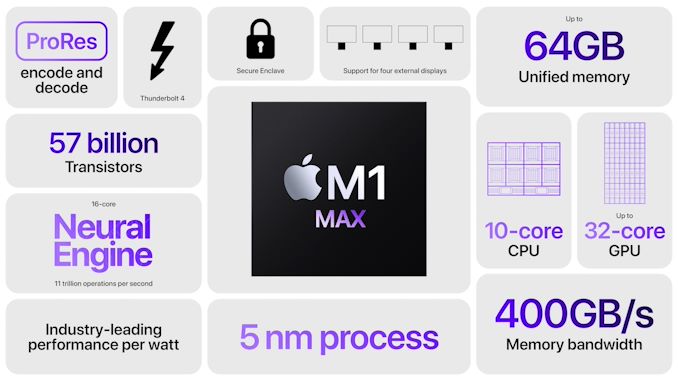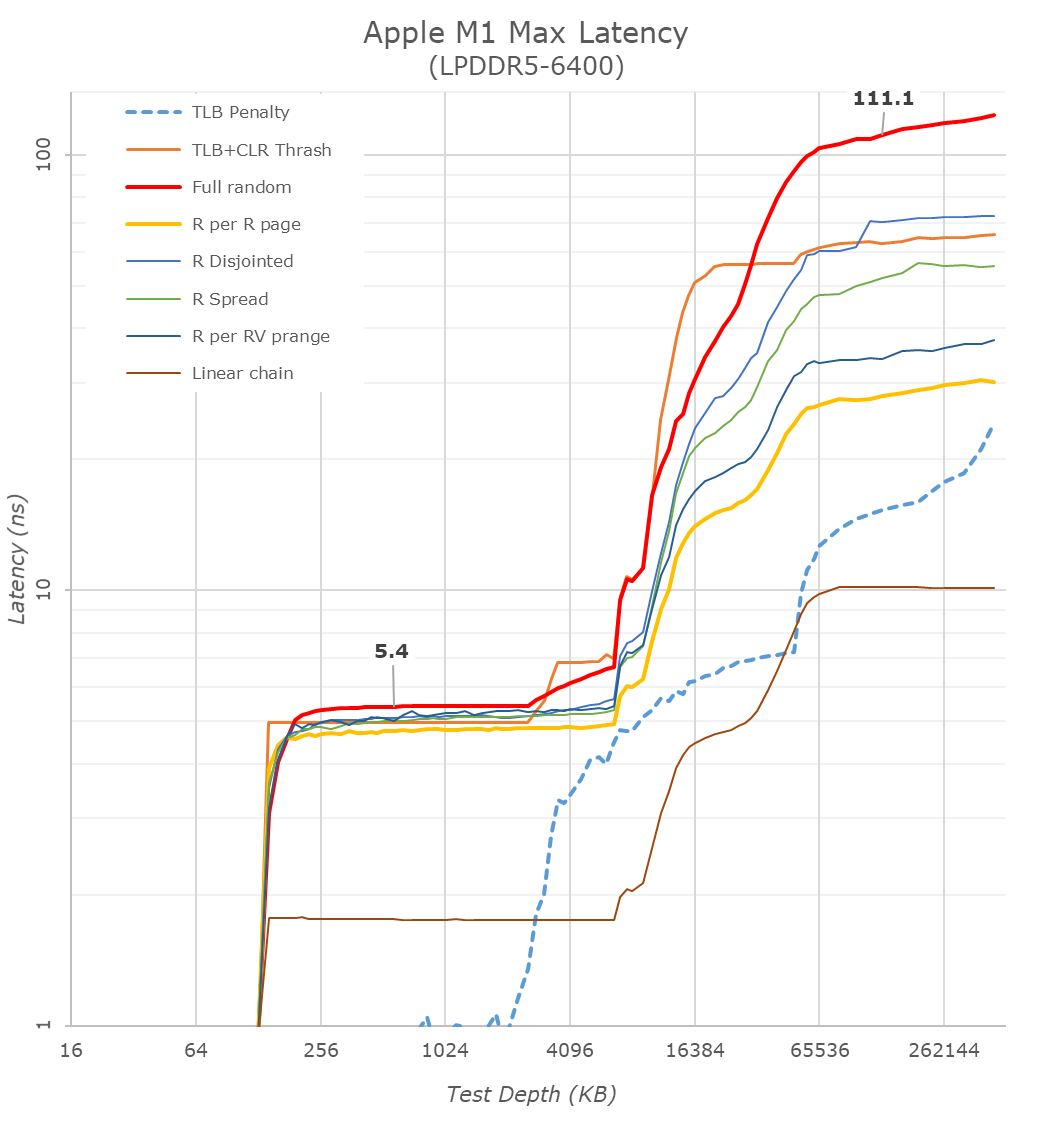Apple's M1 Pro, M1 Max SoCs Investigated: New Performance and Efficiency Heights
by Andrei Frumusanu on October 25, 2021 9:00 AM EST- Posted in
- Laptops
- Apple
- MacBook
- Apple M1 Pro
- Apple M1 Max
Huge Memory Bandwidth, but not for every Block
One highly intriguing aspect of the M1 Max, maybe less so for the M1 Pro, is the massive memory bandwidth that is available for the SoC.
Apple was keen to market their 400GB/s figure during the launch, but this number is so wild and out there that there’s just a lot of questions left open as to how the chip is able to take advantage of this kind of bandwidth, so it’s one of the first things to investigate.
Starting off with our memory latency tests, the new M1 Max changes system memory behaviour quite significantly compared to what we’ve seen on the M1. On the core and L2 side of things, there haven’t been any changes and we consequently don’t see much alterations in terms of the results – it’s still a 3.2GHz peak core with 128KB of L1D at 3 cycles load-load latencies, and a 12MB L2 cache.
Where things are quite different is when we enter the system cache, instead of 8MB, on the M1 Max it’s now 48MB large, and also a lot more noticeable in the latency graph. While being much larger, it’s also evidently slower than the M1 SLC – the exact figures here depend on access pattern, but even the linear chain access shows that data has to travel a longer distance than the M1 and corresponding A-chips.
DRAM latency, even though on paper is faster for the M1 Max in terms of frequency on bandwidth, goes up this generation. At a 128MB comparable test depth, the new chip is roughly 15ns slower. The larger SLCs, more complex chip fabric, as well as possible worse timings on the part of the new LPDDR5 memory all could add to the regression we’re seeing here. In practical terms, because the SLC is so much bigger this generation, workloads latencies should still be lower for the M1 Max due to the higher cache hit rates, so performance shouldn’t regress.
A lot of people in the HPC audience were extremely intrigued to see a chip with such massive bandwidth – not because they care about GPU or other offload engines of the SoC, but because the possibility of the CPUs being able to have access to such immense bandwidth, something that otherwise is only possible to achieve on larger server-class CPUs that cost a multitude of what the new MacBook Pros are sold at. It was also one of the first things I tested out – to see exactly just how much bandwidth the CPU cores have access to.
Unfortunately, the news here isn’t the best case-scenario that we hoped for, as the M1 Max isn’t able to fully saturate the SoC bandwidth from just the CPU side;
From a single core perspective, meaning from a single software thread, things are quite impressive for the chip, as it’s able to stress the memory fabric to up to 102GB/s. This is extremely impressive and outperforms any other design in the industry by multiple factors, we had already noted that the M1 chip was able to fully saturate its memory bandwidth with a single core and that the bottleneck had been on the DRAM itself. On the M1 Max, it seems that we’re hitting the limit of what a core can do – or more precisely, a limit to what the CPU cluster can do.
The little hump between 12MB and 64MB should be the SLC of 48MB in size, the reduction in BW at the 12MB figure signals that the core is somehow limited in bandwidth when evicting cache lines back to the upper memory system. Our test here consists of reading, modifying, and writing back cache lines, with a 1:1 R/W ratio.
Going from 1 core/threads to 2, what the system is actually doing is spreading the workload across the two performance clusters of the SoC, so both threads are on their own cluster and have full access to the 12MB of L2. The “hump” after 12MB reduces in size, ending earlier now at +24MB, which makes sense as the 48MB SLC is now shared amongst two cores. Bandwidth here increases to 186GB/s.
Adding a third thread there’s a bit of an imbalance across the clusters, DRAM bandwidth goes to 204GB/s, but a fourth thread lands us at 224GB/s and this appears to be the limit on the SoC fabric that the CPUs are able to achieve, as adding additional cores and threads beyond this point does not increase the bandwidth to DRAM at all. It’s only when the E-cores, which are in their own cluster, are added in, when the bandwidth is able to jump up again, to a maximum of 243GB/s.
While 243GB/s is massive, and overshadows any other design in the industry, it’s still quite far from the 409GB/s the chip is capable of. More importantly for the M1 Max, it’s only slightly higher than the 204GB/s limit of the M1 Pro, so from a CPU-only workload perspective, it doesn’t appear to make sense to get the Max if one is focused just on CPU bandwidth.
That begs the question, why does the M1 Max have such massive bandwidth? The GPU naturally comes to mind, however in my testing, I’ve had extreme trouble to find workloads that would stress the GPU sufficiently to take advantage of the available bandwidth. Granted, this is also an issue of lacking workloads, but for actual 3D rendering and benchmarks, I haven’t seen the GPU use more than 90GB/s (measured via system performance counters). While I’m sure there’s some productivity workload out there where the GPU is able to stretch its legs, we haven’t been able to identify them yet.
That leaves everything else which is on the SoC, media engine, NPU, and just workloads that would simply stress all parts of the chip at the same time. The new media engine on the M1 Pro and Max are now able to decode and encode ProRes RAW formats, the above clip is a 5K 12bit sample with a bitrate of 1.59Gbps, and the M1 Max is not only able to play it back in real-time, it’s able to do it at multiple times the speed, with seamless immediate seeking. Doing the same thing on my 5900X machine results in single-digit frames. The SoC DRAM bandwidth while seeking around was at around 40-50GB/s – I imagine that workloads that stress CPU, GPU, media engines all at the same time would be able to take advantage of the full system memory bandwidth, and allow the M1 Max to stretch its legs and differentiate itself more from the M1 Pro and other systems.













493 Comments
View All Comments
caribbeanblue - Saturday, October 30, 2021 - link
Lol, you're just a troll at this point.sharath.naik - Monday, October 25, 2021 - link
The only reason M1 falls behind 3060 RTX is because the games are emulated.. if native M1 will match 3080. This is remarkable.. time for others to shift over to the same shared high bandwith memory on chip.vlad42 - Monday, October 25, 2021 - link
Go back and reread the article. Andrei explicitly mentioned that the games were GPU bound, not CPU bound. Here are the relevant quotes:Shadow of the Tomb Raider:
"We have to go to 4K just to help the M1 Max fully stretch its legs. Even then the 16-inch MacBook Pro is well off the 6800M. Though we’re definitely GPU-bound at this point, as reported by both the game itself, and demonstrated by the 2x performance scaling from the M1 Pro to the M1 Max."
Borderlands 3:
"The game seems to be GPU-bound at 4K, so it’s not a case of an obvious CPU bottleneck."
web2dot0 - Tuesday, October 26, 2021 - link
I heard otherwise on m1 optimized games like WoWAshlayW - Tuesday, October 26, 2021 - link
4096 ALU at 1.3 GHz vs 6144 ALU at 1.4-1.5 Ghz? What makes you think Apple's GPU is magic sauce?Ppietra - Tuesday, October 26, 2021 - link
Not going to argue that Apple's GPU is better, however the number of ALU and clock speed doesn’t tell the all story.Sometimes it can be faster not because it can work more but because it reduces some bottlenecks and because it works in a smarter way (by avoiding doing work that is not necessary for the end result).
jospoortvliet - Wednesday, October 27, 2021 - link
Thing is also that the game devs didn't write their game for and test on these gpus and drivers. Nor did Apple write or optimize their drivers for these games. Both of these can easily make high-double digit differences, so being 50% slower on a fully new platform without any optimizations and running half-emulated code is very promising.varase - Thursday, November 4, 2021 - link
Apple isn't interested in producing chips - they produce consumer electronics products.If they wanted to they could probably trash AMD and Intel by selling their silicon - but customers would expect them to remain static and support their legacy stuff forever.
When Apple finally decided ARMv7 was unoptimizable, they wrote 32 bit support out of iOS and dropped those logic blocks from their CPUs in something like 2 years. No one else can deprecate and shed baggage so quickly which is how they maintain their pace of innovation.
halo37253 - Monday, October 25, 2021 - link
Apple's GPU isn't magic. It is not going to be any more efficient than what Nvidia or AMD have.Clearly a Apple GPU that only uses around 65watts is going to compete with a Nvidia or AMD GPU that only uses around 65watts in actual usage.
Apple clearly has a node advantage at work here, and with that being said. It is clear to see that when it comes to actual workloads like games, Apple still has some work to do efficiency wise. As their GPU in the same performance/watt range compared to a Nvidia chip in the same performance/watt range on a older and not as power efficient node is able to still do better.
Apple's GPU is a compute champ and great for workloads that avg user will never see. This is why the M1 Pro makes a lot more sense then the M1 Max. The M1 Max seems like it will do fine for light gaming, but the cost of that chip must be crazy. It is a huge chip. Would love to see one in a mac mini.
misan - Monday, October 25, 2021 - link
Just replace GPU by CPU and you will see how devoid of logic your argument is.Apple has much more experience in low-power GPU design. Their silicon is specifically optimized for low-power usage. Why wouldn't it be more efficient than the competitors?
Besides, Andreis' test already confirm that your claims are pure speculation without any factual basis. Look at the power usage tests for the GFXbench. Almost three times lower power consumption with a better overall result.
These GPUs are incredible rasterizers. It's that you look at bad quality game ports and decide that they reflect the maximal possible reachable performance. Sure, GFXbench is crap, then look at Wild Life Extreme. That result translates to 20k points. Thats on par with the mobile RTX 3070 at 100W.